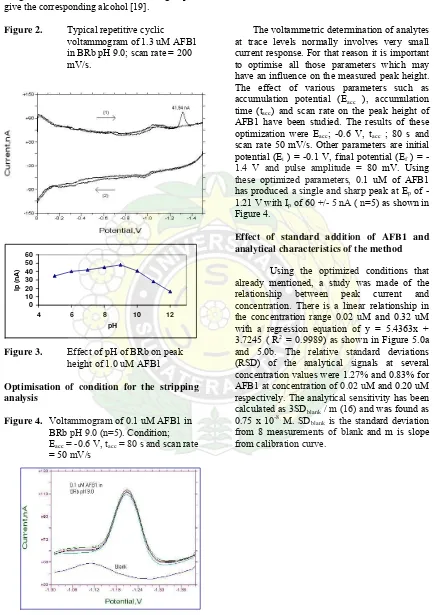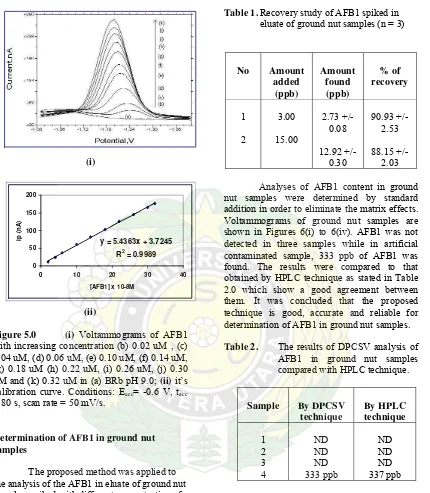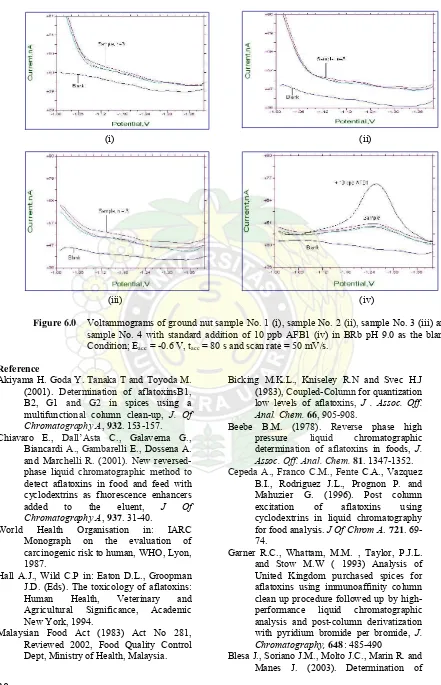O
O O
O O
O
DETERMINATION OF THE AFLATOXIN B1 IN GROUND NUT BY
DIFFERENTIAL PULSE CATHODIC STRIPPING
VOLTAMMETRY (DPCSV) TECHNIQUE
Mohammad Hadzri Yaacob1, Abdull Rahim Hj.Mohd. Yusoff2, Rahmalan Ahamad2, Marpongahtun3
1
Scholl of Health Sceinces, USM, 16150 Kubang Krian, Kelantan, Malaysia
2
Dept.of Chemistry Faculty of Sciences, UTM, 81310 UTM, Skudai, Johor , Malaysia
3Dept. of Chemistry, Faculty of Mathematic and Sciences, USU, Medan, Indonesia
Abstract
An electro analytical method has been developed for the detection and determination of the 2,3,6a,9a-tetrahydro-4-methoxycyclo penta[c] furo[3’,2’:4,5] furo [2,3-h][l] benzopyran-1,11-dione (aflatoxin B1, AFB1) by a differential pulse cathodic stripping voltammetry on a hanging mercury drop electrode (HMDE) in aqueous solution with Britton-Robinson buffer (BRb) as supporting electrolyte. Effect of instrumental parameters such as accumulation potential (Eacc), accumulation time (tacc) and scan rate (v) were examined. The best condition were
found to be pH 9.0, Eacc of -0.6 V, tacc of 80 s and v; 50 mV/s. Calibration curve is linear in the range of 0.02 to
0.32 uM with a detection limit of 0.75 x 10-8 M (3SDblank/m). Relative standard deviation for a replicate
measurements of AFB1 ( n= 8) with the concentrations of 0.02 and 0.20 uM were 1.27% and 0.83% respectively. The method is applied for determination of the AFB1 in ground nut samples after extraction and clean-up steps. The recovery values obtained in spiked ground nut sample are 90.93 +/- 2.53 % for 3.0 ppb and 86.15 +/- 2.03 % for 15.0 ppb of AFB1.
Keywords: Cathodic stripping voltammetry; aflatoxin B1; ground nut
INTRODUCTION
Aflatoxins are mycotoxin produced by certain fungi especially, Aspergillus flavus and parasiticus , and they display strong carcinogenicity [1]. Therefore, they are dangerous food contaminants and many countries have stringent regulatory demands on the level of aflatoxins permitted in imported and traded commodities. Aflatoxin B1, B2, G1 and G2 are the main toxins and may be present in many foodstuff or animal feed such as maize, peanuts, nuts, copra and cottonseeds [2]. Of these, AFB1 (Fig 1) is the most commonly occurring variety and one of the most toxic [3]. The order of toxicity , AFB1 > AFG1 > AFB2 > AFG2, indicates that the terminal furan moiety of AFB1 is a critical point for determining the degree of biological activity of this group of mycotoxins [4].
Figure 1. Structural formula of AFB1
methods, however, require specialist equipment operated by skilled personnel and expensive instruments and high maintenance cost [11].
Due to all these reasons, a voltammetric technique which is fast, accurate and requires low cost equipment [12] is proposed. This technique uses the concept where the peak height of reduction peak of AFB1 is measured when a certain potential is applied [13]. Previous experiment using cyclic voltammetric technique showed that AFB1 reduced at mercury electrode and the reaction is totally irreversible [14]. This work aimed to study and develop a DPCSV method for determination of AFB1 at trace levels and to determine this aflatoxin in ground nut samples. No such report has been published regarding the determination of AFB1 in ground nut using this technique until now.
MATERIAL AND METHOD
Apparatus
Voltammetric measurements were performed using BAS CV-50W voltammetric analyzer with Control Growth Mercury Electrode (CGME) stand. The three-electrode system consisted of a CGME as working electrode, Ag/AgCl2 reference electrode and
platinum wire as the auxiliary electrode. A 20 ml capacity measuring cell was used for placing supporting electrolyte and sample analytes. All measurements were carried out at room temperature. All pH measurements were made with Cyberscan pH meter, calibrated with standard buffers (pH 4, 7 and 10) at room temperature.
Reagents
AFB1 standard. (1mg per bottle) was purchased from Sigma Co. and was used without further purification. Stock solution ( 10 ppm) in hexane:acetonitrile (98:2) were prepared and was stored in the dark at -4 0 C. The diluted solution were prepared daily by using certain volume of stock solution, degassed by nitrogen until dryness and redissolved in Britton-Robinson solution at pH 9.0.
Britton-Robinson buffer solution was prepared from a stock solution 0.04 M phosphoric (Merck), boric (Merck) and acetic (Merck) acids. BRb solution with other pH also was prepared by adding sodium hydroxide (Merck) 1.0 M up to pH value required. All solutions were prepared in double distilled dionised water. All chemicals were of analytical grade reagents.
General procedure
For voltammetric experiments, 10 ml of Britton-Robinson buffer solution was placed in a voltammetric cell, through which a nitrogen stream was passed for 600 s before recording the voltammogram. The selected Eacc = - 600
mV was applied during the tacc = 80 s while the
solution was kept under stirring. After the accumulation time had elapsed, stirring was stopped and the selected accumulation potential was kept on mercury drop for a rest time (tr = 10
s), after which a potential scan was performed between -0.950 and -1.500 V by DPCSV.
Procedure for the determination in ground nut samples
Four batches of ground nut included an artificial contaminated have been analysed for AFB1 content. AFB1was extracted from ground nut samples according to the standard procedure developed by Chemistry Department, Penang Branch, Ministry Of Science, Technology and Innovation (MOSTI), Malaysia [15]. 1ml of the final solution from extraction and clean-up steps in chloroform was pipette into an amber bottle, degassed with nitrogen and re-dissolved in 1ml of Britton-Robinson. 200 ul of this solution was spiked into 10 ml supporting electrolyte in volumetric cell. After that, the general procedure was applied and voltammogram of sample was recorded. A 10 ppb of AFB1 standard solution was then spiked into the sample solution before general procedure for voltammetric analysis The content of AFB1 in ground nut sample was calculated based on standard addition method to minimize any matrix effect.
RESULT AND DISCUSSION
Cyclic voltammetric determination of AFB1 Cyclic voltammogram of 1.3 uM AFB1 in Britton-Robinson buffer solution as shown in Figure 2 indicates the non-reversibility of the electrode process. It is also confirmed by the study of the influence of the scan rate in this technique, where a linear relationship between peak potential (Ep ) and log scan rate was found
as Ep (-mV) = 61.41x + 1171.6 (R2 = 0.9967).
Effect of pH
0 10 20 30 40 50 60
4 6 8 10 12
pH
Ip
(
n
A
)
assigned to the reduction of the ketone group to give the corresponding alcohol [19].
Figure 2. Typical repetitive cyclic voltammogram of 1.3 uM AFB1 in BRb pH 9.0; scan rate = 200 mV/s.
Figure 3. Effect of pH of BRb on peak height of 1.0 uM AFB1
Optimisation of condition for the stripping analysis
Figure 4. Voltammogram of 0.1 uM AFB1 in BRb pH 9.0 (n=5). Condition; Eacc = -0.6 V, tacc = 80 s and scan rate
= 50 mV/s
The voltammetric determination of analytes at trace levels normally involves very small current response. For that reason it is important to optimise all those parameters which may have an influence on the measured peak height. The effect of various parameters such as accumulation potential (Eacc ), accumulation
time (tacc) and scan rate on the peak height of
AFB1 have been studied. The results of these optimization were Eacc; -0.6 V, tacc ; 80 s and
scan rate 50 mV/s. Other parameters are initial potential (Ei ) = -0.1 V, final potential (Ef ) =
-1.4 V and pulse amplitude = 80 mV. Using these optimized parameters, 0.1 uM of AFB1 has produced a single and sharp peak at Ep of
-1.21 V with Ip of 60 +/- 5 nA ( n=5) as shown in
Figure 4.
Effect of standard addition of AFB1 and analytical characteristics of the method
Using the optimized conditions that already mentioned, a study was made of the relationship between peak current and concentration. There is a linear relationship in the concentration range 0.02 uM and 0.32 uM with a regression equation of y = 5.4363x + 3.7245 ( R2 = 0.9989) as shown in Figure 5.0a and 5.0b. The relative standard deviations (RSD) of the analytical signals at several concentration values were 1.27% and 0.83% for AFB1 at concentration of 0.02 uM and 0.20 uM respectively. The analytical sensitivity has been calculated as 3SDblank / m (16) and was found as
0.75 x 10-8 M. SDblank is the standard deviation
y = 5.4363x + 3.7245
Figure 5.0 (i) Voltammograms of AFB1 with increasing concentration (b) 0.02 uM , (c) 0.04 uM, (d) 0.06 uM, (e) 0.10 uM, (f) 0.14 uM, (g) 0.18 uM (h) 0.22 uM, (i) 0.26 uM, (j) 0.30 uM and (k) 0.32 uM in (a) BRb pH 9.0; (ii) it’s calibration curve. Conditions: Eacc= -0.6 V, tacc
= 80 s, scan rate = 50 mV/s.
Determination of AFB1 in ground nut samples
The proposed method was applied to the analysis of the AFB1 in eluate of ground nut samples, spiked with different concentration of AFB1 for recovery studies. In this study, the concentrations used were 3.0 ppb and 15.0 ppb The results of this studies are represented in Table 1.0. The results show that the accuracy of the method is good.
Table 1. Recovery study of AFB1 spiked in eluate of ground nut samples (n = 3)
Analyses of AFB1 content in ground nut samples were determined by standard addition in order to eliminate the matrix effects. Voltammograms of ground nut samples are shown in Figures 6(i) to 6(iv). AFB1 was not detected in three samples while in artificial contaminated sample, 333 ppb of AFB1 was found. The results were compared to that obtained by HPLC technique as stated in Table 2.0 which show a good agreement between them. It was concluded that the proposed technique is good, accurate and reliable for determination of AFB1 in ground nut samples.
Table 2. The results of DPCSV analysis of AFB1 in ground nut samples compared with HPLC technique.
(i) (ii)
(iii) (iv)
Figure 6.0 Voltammograms of ground nut sample No. 1 (i), sample No. 2 (ii), sample No. 3 (iii) and sample No. 4 with standard addition of 10 ppb AFB1 (iv) in BRb pH 9.0 as the blank. Condition; Eacc = -0.6 V, tacc = 80 s and scan rate = 50 mV/s.
Reference
Akiyama H. Goda Y. Tanaka T and Toyoda M. (2001). Determination of aflatoxinsB1, B2, G1 and G2 in spices using a multifunctional column clean-up, J. Of Chromatography A, 932. 153-157.
Chiavaro E., Dall’Asta C., Galaverna G., Biancardi A., Gambarelli E., Dossena A. and Marchelli R. (2001). New reversed-phase liquid chromatographic method to detect aflatoxins in food and feed with cyclodextrins as fluorescence enhancers added to the eluent, J Of Chromatography A, 937. 31-40.
World Health Organisation in: IARC Monograph on the evaluation of carcinogenic risk to human, WHO, Lyon, 1987.
Hall A.J., Wild C.P in: Eaton D.L., Groopman J.D. (Eds). The toxicology of aflatoxins: Human Health, Veterinary and Agricultural Significance, Academic New York, 1994.
Malaysian Food Act (1983) Act No 281, Reviewed 2002, Food Quality Control Dept, Ministry of Health, Malaysia.
Bicking M.K.L., Kniseley R.N and Svec H.J (1983), Coupled-Column for quantization low levels of aflatoxins, J . Assoc. Off. Anal. Chem. 66, 905-908.
Beebe B.M. (1978). Reverse phase high pressure liquid chromatographic determination of aflatoxins in foods, J. Assoc. Off. Anal. Chem. 81. 1347-1352. Cepeda A., Franco C.M., Fente C.A., Vazquez
B.I., Rodriguez J.L., Prognon P. and Mahuzier G. (1996). Post column excitation of aflatoxins using cyclodextrins in liquid chromatography for food analysis. J Of Chrom A. 721. 69-74.
Garner R.C., Whattam, M.M. , Taylor, P.J.L. and Stow M.W ( 1993) Analysis of United Kingdom purchased spices for aflatoxins using immunoaffinity column clean up procedure followed up by high-performance liquid chromatographic analysis and post-column derivatization with pyridium bromide per bromide, J. Chromatography, 648: 485-490
aflatoxins in peanuts by matrix solid-phase dispersion and liquid chromatography. J Of Chrom A. 1011. 49-54.
Garden S.R. and Strachan N.J.C.(2001). Novel colorimetric immunoassay for the detection of aflatoxin B1, Anal Chim Acta, 444. 187-191.
Braitina Kh. Z., Malakhova N.A. and Stojko Y. (2000) Stripping voltammetry in environmental and food analysis, Fresenius J Anal Chem 368: 307-325 Fifield F.W. and Kealey D (2000) Principle and
practice of analytical chemistry 3rd Edition, Blackwell science, UK
Yaacob M.H., Mohd Yusoff A.R. and Ahmad R. (2003). Cyclic voltammetry of AFB2 at the mercury electrode. Paper presented at Simposium Kimia Malaysia ke 13 (SKAM-13), 9 – 11th September 2003, Kucing, Sarawak, Malaysia.


